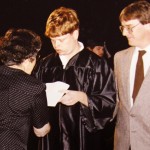- Aaron at Graduation 1997
- Tommy at Graduation
—
Check out the graduation pictures of my two sons.
What’s the same? What’s different?
BACK to SCHOOL Article 3
To celebrate the new school year here are some of my favorite posts:
Article 1: Why Do We Go to School?
Article 2: Back to School| A New Year of Learning
What is Inclusion?
The concept of INCLUSION is both simple and complex.
It means being able to go to the same school your brothers and sisters go to. The same school that is on the realtor’s fact sheet, you know the one: “If you buy this house, here is the neighborhood school you go to.” That’s simple, right?
In 1980 in Ohio, when my son Aaron turned 5 and was eligible to go to school, because he had the label of autism and developmental disabilities, he and other children with IQs below 50 were legally excluded from public schools. That’s complex.
It all changed because of Federal Legislation, yea those dang Government laws everyone hates.
When you suffer from exclusion and segregation, those Federal rules and regulations save the day.
History Lessons: Past
When new schools were built in the 50s-60s-70s-80s, the old white schools became “negro” schools. When even more new schools were built for the white children (think baby boomers), then the children with disabilities were moved up into the schools vacated by the “negroes.”
Schools: White to Negro to Handicapped to Demolished
The Education for All Handicapped Children Act was passed in 1975 and gave parents the right to a free appropriate public education, zero reject, related services, due process and the “least restrictive environment.”
At the time of the Neill Roncker and Aaron Ulrich due process hearings, the decrepit Dyer School was a handicapped-only school. Cincinnati Public Schools rented the school to the Hamilton County Board of Mental Retardation/Developmental Disabilities for $1.00 a year (Roncker hearing).
Parents and local Board of Mental Retardation officials were happy to be able to move out of church basements into the discarded school. They were also thrilled to be building new segregated facilities, handicapped only, with local levy dollars.
That was our court battle–to be able to ride the bus, go to school, eat lunch with typical kids… in our neighborhood school–not a “handicapped-only” school.
Inclusion is a civil right
“Inclusion is a right, not a special privilege for a select few.” – Federal Court, Oberti vs Board of Education.
For information about the history of children with disabilities check out the Minnesota DD Planning council’s excellent resource, Parallels in Time 2
History Lessons| Inclusion Today
Here is a recent video about a young woman with the label of autism. You will see her general education teacher, her parent, her inclusion facilitator, the general music teacher but most of all you will see the future citizens of our country.
Here is a picture of inclusion. A picture of hope. (Thanks to Donna Owens, OCALI)
Thaysa from Dan Habib on Vimeo.
Definition of Inclusion
Giangreco (see Resources) has defined the criteria for inclusion:
Students go to the same school as their brothers, sisters, and neighbors;
They participate in the same environments as their peers (lunchroom, bus, playground, classrooms);
According to their IEP, the student has the extra supports they need to be successful (therapy, adapted curriculum materials, an aide, teacher inservice);
There should be a natural proportion of children with/without disabilities, (if 10% of students are on IEPs in a school–no more than 10% of the students in any one class should be on IEPs).
An Inclusive Graduation Ceremony
So did you see any similiarities and differences in the graduation pictures above?
Almost everything about Tommy and Aaron’s Graduation ceremonies were the same. At the time, Lakota High School was one of the largest high schools in the state. Tommy and Aaron both had HUGE graduating classes held at the University of Cincinnati. Both had cheering parents and friends.
The difference between Aaron’s school experience and his typical brother Tommy’s, is evidenced in their graduation pictures above.
Aaron didn’t have to go through a segregated graduation ceremony and earn the right or prove he was ready to go to the inclusive celebration.
We did prepare by considering what would Aaron need to be added or subtracted from the typical graduation experience.
In his case, Aaron needed an extra support person, his wonderful teacher Mr. Mike Valdini. And, what needed to be subtracted–the mortar board hat!
I like to think our early battles for inclusion help the young children today—all of them, with and without disabilities.
Keep Climbing: Onward and Upward
All my best,
Mary
Comments:
It now seems like the concept of inclusion has been around forever. But like any civil rights movement, we often don’t move forward in a straight line. What are some of your experiences?
Related Posts:
The Values of Inclusion from Down Under
–


